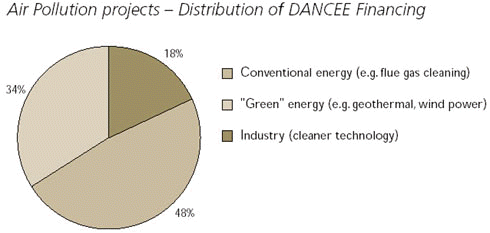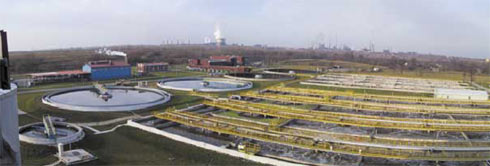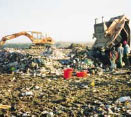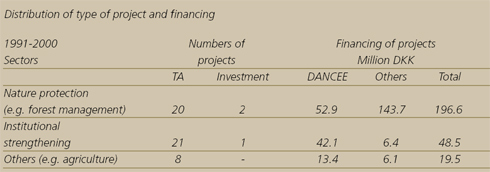Danish-Polish Environmental Co-operation 1991-2000
Chapter
3
The Danish environmental assistance to Poland
The assistance and its environmental results
As a close neighbour, Denmark has assisted Poland in improving the environment for more than ten years. From the beginning in 1991 up to the year 2000, DANCEE has supported as much as 232 environmental projects in Poland with the amount of DKK 635 million (USD 73 million) making Denmark one of the largest bilateral environmental donor to Poland. The Danish assistance has released an additional DKK 5.1 billion (USD 0,58 billion) in co-financing, leading to projects with the total value of almost DKK 6 billion (USD 0,7 billion). Over the years, the assistance has developed into a powerful partnership producing considerable environmental effects in relation to air and water quality, waste treatment and nature protection. Apart from the environmental effects, the partnership has also the important political effect of making Poland capable of fulfilling the environmental requirements for EUmembership. EU-approximation is the current overall objective of all the projects, which formal basis, the Danish-Polish Cooperation Agreement, was renewed for an unlimited period in 1999.
The general Danish awareness on the Polish environment accelerated in the late eighties and became a public issue after a delegation of Danish parliamentarians visited some of the 'black spots' of Poland. The leader of the delegation still remembers the trip clearly - and specially the visit to the power plants of Katowice; "The Polish official pointed to four big chimneys in the horizon and told us that these four chimneys alone produced the same amount of sulphuric dioxide as the total Danish outlet. It became clear to everybody in the delegation that if we wanted cleaner air in Denmark we would have to do something in Poland".
In April 1991 the Danish Parliament passed the Act on Subsidies for Environmental Activities in Eastern European Countries. This marked the beginning of the Danish environmental assistance to Poland.
Of the Eastern European countries, Poland has received the largest environmental assistance, namely 25.7 % of the regional budget. Of the 232 projects in the period, 48% have concerned water pollution and 21% concerned air pollution. The remaining 24% of the projects are distributed in the categories: solid and hazardous waste, nature protection (biological diversity and sustainable forestry), institutional strengthening and 'Others' (primarily related to EU accession).
The co-operation
Over the years, the character of the Danish environmental work has changed from assistance to co-operation. The co-operation is based on an Agreement and a Country Programme. The Co-operation Agreement was originally signed in 1994 for a 5 year period and was renewed in 1999 for an unlimited period.
The co-operation between the Polish Ministry of Environment (PMoE) and the Danish Environmental Protection Agency (DEPA) are formalised in a Steering Committee, supplemented by a working group. The Steering Committee formulates the general policy for the Polish-Danish co-operation as reflected in the Country Programme. Any changes in the strategy must be confirmed by the Steering Committee. The Committee is also responsible for the implementation of necessary adjustments in the priority areas.
The Country Programme
The Country Programme sets out the Environmental Programme Priority Areas for a two year period. The first Country Programme was prepared for the period 1996-97. It was prolonged to include 1998 while the most recent programme for 1999-2000 was adopted in 1999 and is presently up for revision for the period 2001 - 2003.
In accordance with the Country Programme for 1999-2000 (2001), the Danish assistance to protect the environment and natural resources in Poland is focused on the following Pro gramme Priority Areas. The areas are not listed in any order of priority:
| Water and Waste water | |
| Air Pollution and Energy | |
| Waste | |
| Cleaner Technology | |
| Nature Conservation |
With Poland on the way to EU, EUapproximation has been the overall objective in all the projects. The principles of the new 2001-2003 Country Programme, which is presently being formulated, is introduced in the chapter "Future perspectives".

Air Pollution
The air pollution projects can be divided into:
| projects concerning conventional energy production (e.g. flue gas cleaning at power plants) | |
| renewable or "green" energy production | |
| and projects within the production industry (e.g. cleaner technology or end-ofpipe solutions). |
Most of the supported projects are investment projects and are primarily related to energy production. Most of the financing has been allocated for investments in flue gas cleaning at power plants as well as to the support of the development of the exploitation of geothermal energy.

The estimated environmental effects for selected indicators are shown in the figure below. Seen from a Danish perspective, it is noteworthy that the reduction of sulphur dioxide is at the same level as the total yearly emissions in Denmark and equals 11 % of the total emission from Polish power plants. The reduction in particles/dust is also significant, it equals 20% of the Polish power plant emissions!
There is no doubt that the reduction in emissions are significant. The fact is that the results have shown the possibility of combining the last decades of social and economical development in Poland with the environmental development.
Water Pollution
This category covers municipal and industrial waste water treatment, water supply, groundwater, surface water and recipients. The focus has been on municipal waste water treatment projects for which 73% of the grants to the water sector has been dedicated.
This category also covers 49% of all the projects.
The contribution from co-financing is approx. 90% and DANCEE has typically ensured the final part of the financing.
Focusing on the traditional environmental indicators for waste water treatment (organic matter, nitrogen and phosphorus in the effluent), the yearly reduction in pollution equals the pollution from nearly 2 million inhabitants. This figure is comparable to the pollution from as much as all citizens in Warsaw or Copenhagen! Another very significant result of DANCEE supported projects shows a reduction of the discharge of organic pollutants and nutrients (phosphorus) to the Baltic Sea by 14%. This reduction of organic matter corresponds with more than 3 times the discharge from all Danish WWTPs!

Two DANCEE financed projects. In the foreground a waste water treatment plant in
Krakow. In the background the Huta Sendzimira, the second largest steelwork in Poland,
where DANCEE has supported environmental improvements

Concerning water resources, the projects have resulted in water savings or new production of water of approx. 12 million m3 drinking water which equals the water consumption of approx. 175.000 citizens.
Solid and Hazardous Waste
Most of the projects have involved technical assistance for the municipal waste management planning in Polish cities. However, investment projects have also been implemented in which new treatment technologies such as incineration of hazardous waste, only and composting, recycling and sorting of waste have been demonstrated.
Waste projects - distribution of DANCEE financing
Focusing on the environmental effects of the projects, the landfill capacity created by the projects is approx. 350,000 t. This can be compared to the approximate annual Polish waste generation in 1997 which was 30,000,000 t. The Danish waste generation was 2,900,000 t/y and the capacity equals 12% of the Danish capacity.
The generated hospital waste incineration capacity equals 3.3% of the total Polish hospital waste generation.



Biological Diversity and Sustainable Forestry
Several technical assistance projects have been implemented within the sector related to nature protection. The contribution from cofinancing has been approx. 75%.
The projects include both forest and nature reserve management and covers totally more than 6,000 km2. Most forestry projects have been nature protecting projects while the nature reserve projects have focused on specific areas and in particular 3 national parks (Biebrza, Wigry and Bialowieza).
Other Sectors
Several technical assistance projects have been implemented in the categories Institutional strengthening and others e.g. national oil spill.
For institutional strengthening and other technical assistance projects, the contribution from co-financing has been 17-29%. The focus has been on institutional strengthening and the approximation to the EU legislation in particular. It has mainly been the implementation of various directives (IPPC and EIA).
